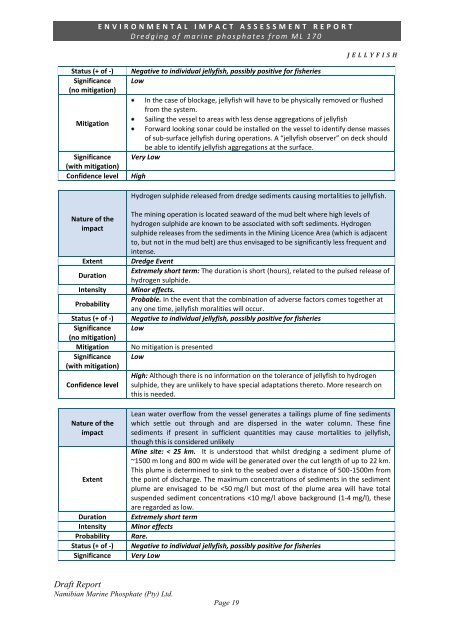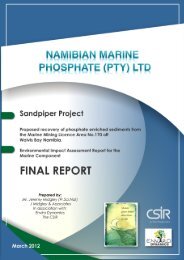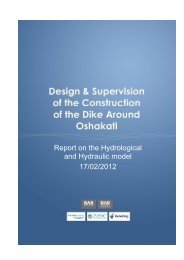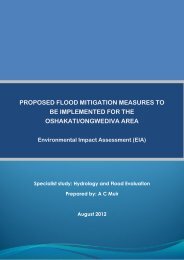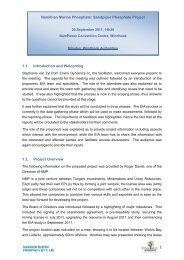Appendix 1d - Jellyfish Study.pdf - Enviro Dynamics Namibia
Appendix 1d - Jellyfish Study.pdf - Enviro Dynamics Namibia
Appendix 1d - Jellyfish Study.pdf - Enviro Dynamics Namibia
Create successful ePaper yourself
Turn your PDF publications into a flip-book with our unique Google optimized e-Paper software.
E N V I R O N M E N T A L I M P A C T A S S E S S M E N T R E P O R TD r e d g i n g o f m a r i n e p h o s p h a t e s f r o m M L 1 7 0J E L L Y F I S HStatus (+ of -)Significance(no mitigation)MitigationSignificance(with mitigation)Confidence levelNegative to individual jellyfish, possibly positive for fisheriesLowIn the case of blockage, jellyfish will have to be physically removed or flushedfrom the system.Sailing the vessel to areas with less dense aggregations of jellyfishForward looking sonar could be installed on the vessel to identify dense massesof sub-surface jellyfish during operations. A “jellyfish observer” on deck shouldbe able to identify jellyfish aggregations at the surface.Very LowHighHydrogen sulphide released from dredge sediments causing mortalities to jellyfish.Nature of theimpactExtentDurationIntensityProbabilityStatus (+ of -)Significance(no mitigation)MitigationSignificance(with mitigation)Confidence levelNature of theimpactExtentDurationIntensityProbabilityStatus (+ of -)SignificanceThe mining operation is located seaward of the mud belt where high levels ofhydrogen sulphide are known to be associated with soft sediments. Hydrogensulphide releases from the sediments in the Mining Licence Area (which is adjacentto, but not in the mud belt) are thus envisaged to be significantly less frequent andintense.Dredge EventExtremely short term: The duration is short (hours), related to the pulsed release ofhydrogen sulphide.Minor effects.Probable. In the event that the combination of adverse factors comes together atany one time, jellyfish moralities will occur.Negative to individual jellyfish, possibly positive for fisheriesLowNo mitigation is presentedLowHigh: Although there is no information on the tolerance of jellyfish to hydrogensulphide, they are unlikely to have special adaptations thereto. More research onthis is needed.Lean water overflow from the vessel generates a tailings plume of fine sedimentswhich settle out through and are dispersed in the water column. These finesediments if present in sufficient quantities may cause mortalities to jellyfish,though this is considered unlikelyMine site: < 25 km. It is understood that whilst dredging a sediment plume of~1500 m long and 800 m wide will be generated over the cut length of up to 22 km.This plume is determined to sink to the seabed over a distance of 500-1500m fromthe point of discharge. The maximum concentrations of sediments in the sedimentplume are envisaged to be


